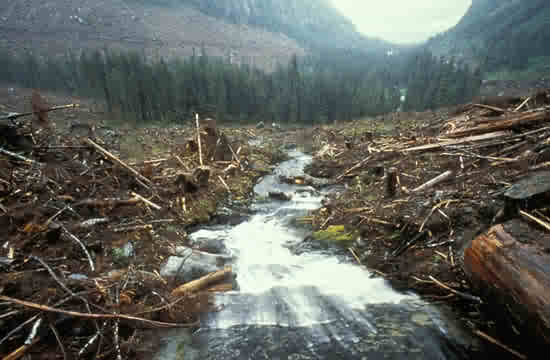A Sustainable Scale Perspective: Setting Limits
A sustainable scale perspective is an approach to solving the unprecedented global challenges we face, as well as future ecological challenges yet unforeseen. This perspective has the following characteristics, and is very much a work in progress.
Accepting Limits 
The major threat to a desirable human future is a level of material throughput which exceeds ecologically sustainable scale (see
Areas of Concern). Thus a key characteristic of any enduring human society must be to ensure throughput remains within the regenerative and absorptive capacities of critical ecosystems; that we live off the income from natural capital, and preserve the natural capital itself. This means setting limits to material throughput, and organizing the main drivers of throughput – economic growth, an expanding human population, and wasteful technologies - to ensure these limits are respected.
Limits Do Not Mean Deprivation
The notion of limits is contrary to the currently dominant economic and cultural paradigm. Many of humanity’s institutions, cultural myths, and visual icons assume and encourage continuous economic growth. Yet limits are a biophysical reality, and will affect our well-being whether we recognize them or not. The mere mention of limits may conjure up fearful images of deprivation and return to a primitive existence. However, it is the continuous growth of absolute levels of material throughput that should be feared, as it will inevitably lead to deprivation and a reduced quality of life (see
Sustainable Or Unsustainable).
Limits Do Not Mean Authoritarian Control
The notion of limits may also arouse concerns about the controls needed to maintain them. Centrally planned command and control economies did not fare well in the last century. Micromanaging economic activities would be costly, cumbersome, constraining, and counterproductive. Policy approaches are available that set macro-level goals, and leave many of the allocation challenges to the market (
Supportive Public Policies).
The irony is that the longer we avoid limits, the quicker we will experience ever increasing levels of deprivation, thereby reducing our options for achieving sustainable scale. More authoritarian approaches will be needed if both our natural capital and options for self-management continue to dwindle. Accepting the goal of limited throughput can provide us with greater security and well-being than the illusory and impossible promises of continuous economic growth.
Limits Are Commonplace
Ignoring the limit of material throughput that ecosystems can tolerate is a curious phenomenon, given our ready acceptance of limits in so many other spheres of life. We accept that we cannot fly like superman, be beamed star trek-style half way around the world, or exercise our intelligence to solve any problem put before us. These are limits imposed by nature. We also observe stop signs when driving, refrain from murdering those we disagree with, and don’t allow smoking in public places. These are social limits that enhance our safety and well being.
We accept these limits for the common good and have learned we can enjoy ourselves and function freely within their confines. As with all limits that have value, they are generally “invisible”. Yet the reality of biophysical limits to throughput is viewed as heresy.
Guidelines for Respecting Limits
The purpose of respecting limits is to ensure our activities allow us to live off the income from natural capital, rather than drawing down the stock of natural capital itself (see
Natural Capital and Income). How do we do this?
The first guideline to ensure sustainable scale is that we harvest renewable resources below the natural regeneration rates of all critical ecosystem services associated with specific throughput activities.
When a forest or marine ecosystem produces lumber or fish, their harvest should remain below the rate at which the lumber or fish are regenerated by these ecosystems. If the throughput, or harvest, exceeds the regeneration rate, we are exceeding sustainable scale and are decreasing the fund of natural capital upon which our harvest depends – the forest or fish, respectively. Continued liquidation of natural capital will eventually degrade the ecosystem’s capacity to regenerate at the rate needed to maintain human needs, and result in deforestation or collapse of fisheries, as has happened around the world.
Cutting Nature Some Slack This rule requires us to maintain extraction/harvest rates below regeneration rates. When we extract resources at or too near the regeneration rate we run the risk of exceeding sustainable scale and reducing ecosystem resilience. Greater safety lies in erring on the side of preserving rather than degrading natural capital, especially when potentially irrevocable changes in critical ecosystem services are at stake.
Estimates of regeneration rates will be fragmented, incomplete and unreliable, dependent on a wide variety of difficult to foresee factors. As our scientific understanding of ecosystem services and dynamics improves, estimates may become more reliable. But some degree of uncertainty will always remain. Just how far below the regeneration rate the harvest should be is a matter of optimal scale and is discussed below.

Consider All Relevant Services This rule recognizes that harvesting a specific resource (e.g. lumber) affects many other ecosystem services associated with the fund from which the stock is taken (e.g. the forest). Cutting trees not only provides lumber but also affects soil erosion, water retention and a host of other ecosystem services provided by the forest. Those services that are important to human well-being, the loss of which would be irrevocable, are identified as critical (see
Critical Natural Capital). When applying this rule consideration needs to be given to all affected critical ecosystem services, not just the resource of commercial interest.
It is possible that the regeneration rates for some critical ecosystem services are exceeded, even though sustainable levels of resource extraction appear to be respected. Sustainability should be viewed in terms of all critical ecosystem services which are affected by extraction, not just the resource stock. For example, the harvest of lumber may be less than the regeneration rate of lumber, and by this criterion alone, appear sustainable.
However, if the harvest involves multiple roads through the forest, then other critical ecosystem services such as flood control or habitat protection might be compromised. If they are degraded below the level required for human well-being, then the sustainable scale of the lumber harvest will have been exceeded. The emission of CFCs was considered safe because the compounds were inert and non-polluting. Yet these very characteristics that made them appear safe at one level, were precisely those characteristics that made them dangerous in terms of ozone depletion in the upper atmosphere (see
Ozone).
The second guideline of sustainable scale is that we maintain our rate of throughput so that their emissions or wastes do not exceed the rates that can be absorbed or broken down by natural processes in a meaningful time span.
Sinks as Serious as Sources The most serious examples of unsustainable scale are the result of violating this rule (see
Areas of Concern). Wastes from industrial agriculture exceed sustainable scale for many local and regional sinks. Emission of ozone depleting compounds very rapidly resulted in destruction of the protective atmospheric ozone layer. Anthropogenic emission of greenhouse gases increased the concentration of these substances to levels unprecedented over the course of human civilization,
1 threatening the climate stability our civilization depends on.

Special Cases: Zero Renewal There are two cases where the regeneration rate is zero which are scale relevant flags, calling for special considerations. The first case involves substances for which a critical ecosystem has zero absorptive capacity, and thus cannot be regenerated. Many synthetic organic chemicals fall in this category. In such cases there should be no production of wastes which cannot be broken down and absorbed. The second case involves non-renewable resources and has its own guideline (see the second guideline).
Seek Substitutes When wastes cannot be broken down and absorbed, the need is to find substitutes which are biodegradable for the material in question. The only circumstance which might justify the continued use of a substance which cannot be broken down and absorbed would be one where the benefits to basic human needs were immediate and overwhelming, and the ecosystem in question could be sacrificed, as determined by due process. Economic considerations should not constitute an exception to the guideline.
The
third guideline has to do with non-renewable resources:
any use of non-renewable resources should be coupled with investment in replacing the non-renewable resource with renewable alternatives, or coupling the non-renewable usage with a renewable offset.2 Examples might be using wood instead of plastics, or tree-planting for carbon sequestration, respectively.
This guideline recognizes our civilization’s dependence on a vast and diverse array of non-renewable resources, and the challenges involved in reducing, and if possible eliminating their use, especially those that are most harmful.

Many of these substances are toxic or damaging in use (eg. mercury, plutonium, fossil fuels), or their extraction destroys habitat and erodes biodiversity.
3 There is also a moral concern – if we use up valuable non-renewable substances, then we foreclose their use by future generations. We have an obligation to restrict use of valuable non-renewable resources and minimize their waste. Yet mainstream economics encourages rapid exploitation of these resources, relying on the substitutability of financial capital for any exhausted natural capital.
Dealing With Non-Renewables - The current global economy is a long way from this ideal, and steps such as the following would be helpful:
- Identify for priority application of the third rule those renewable resources whose life cycle throughput are most harmful (e.g. reducing or eliminating mercury, which is a known toxic would have a higher priority than silica, which is non-toxic and abundant)

- Find renewable substitutes for the nonrenewable resources being used or planned for. New design approaches are needed and being developed (see Sustainable Business Practices)
- Devise ways of recycling existing nonrenewable substances so that virgin materials are no longer needed. This requires economic policies which provide incentives for recycling as well as technical improvements, and disincentives for resource extraction (see Supportive Public Policies). Gold, for example, is non-toxic, but the global supply is more than is needed and its extraction is highly destructive to habitat. Recycling could easily maintain the supply needed for new applications, other than for luxury items.
- Design goods which use nonrenewable resources for durability and which can be recycled. Both policy and technical development is needed and being experimented with (see Supportive Public Policies; and Sustainable Business Practices: Extended Producer Responsibility).
The only circumstance in which nonrenewable resource extraction might be justified would be if the benefits in terms of basic human needs were deemed sufficiently critical by due process; economic considerations should not determine exceptions to the rule. If continued use is deemed necessary, then serious research efforts to find substitutes should continue, and the extraction terminated as soon as possible.
Guidelines for Respecting Justice and Safety: Ensuring Ecological Sustainability
The above guielines focus on ecological sustainability, and taken together would go a long way to achieve that goal. However, sustainability from the perspective of a global civilization involves more than ecological considerations. Social and ethical issues are also relevant; without respecting these concerns, ecological sustainability may not be feasible. The Bruntland definition of sustainability reflects both perspectives in its emphasis on responsibility to future generations.
Ethical concerns for future generations apply equally to current generations living in poverty. Meeting the full range of human needs for the global population through continued economic growth is no longer possible once limits are acknowledged. Sharing of resources derived from the income of natural capital alone becomes necessary to achieve social justice as well as ecological sustainability.
The concept of optimal scale integrates both criteria for sustainability, and identifies a number of additional issues to be addressed in implementing a scale perspective. (For a discussion of the practical necessity of social justice to achieve and maintain ecological sustainability, see
Dialogue with the Skeptics, item 12).
Optimal Scale as the Key
Optimal Scale is the key policy objective for a sustainable future. It integrates the goals of ecological sustainability and social justice, by focusing on the relative costs and benefits of marginal increases in throughput, where the costs and benefits include social and ethical as well as economic, considerations. Optimal scale requires due process to ensure justice and safety, as well as ecological sustainability, are adequately considered. Ecological sustainability is covered by the above three guidelines. Some additional guidelines are needed to respect justice and safety concerns.
Justice requires:

- Meeting the basic human needs of the current global population, including the poorest (in contrast to supplying luxuries for those already well off – the priority of the current economic paradigm)
- Meeting the basic human needs of future generations (rather than the current practice of liquidating both non-renewable and renewable resources)
- Preserving biodiversity, thereby respecting the rights of non-human species, and recognizing the delicate and intricate interdependencies of the web of life, of which humans are a part.
Identifying an Adequate Safety Margin requires:
- Review of the scientific knowledge available concerning the ecosystems affected by human activities and the criticality of the services they provide
- An appreciation of the irrevocable nature of ecosystem change beyond a certain point, and the associated loss of life supporting ecosystem services
- Special precautions for making decisions about critical life support functions under conditions of uncertainty
- Identification of at least the minimum information required to make a safe decision
- Ensuring adequate monitoring and enforcement mechanisms are in place to ensure that sustainability and social justice standards are respected
- Ensuring that an informed public participate in the determination of the above justice and safety issues.
The above outline describes the components of optimal scale, but does not describe what the optimal scale should be for any given human activity. The process of identifying optimal scale will be a complex political, social and scientific process, and undoubtedly entail many bumps and starts along the way. Given that many human activities are already unsustainable, the need to begin this process is urgent.
Ranking Allocation, Distribution and Scale Priorities 
Mainstream economic theory and practice places the highest priority on market allocation of resources. Distribution, or justice concerns are secondary and discussions of scale are almost nonexistent in mainstream discourse. Optimal scale requires a reversal of this priority ranking.
Ecological scale issues are most fundamental, relying as they do on laws of nature. Determining throughput levels that are within a sustainable scale range are therefore the first priority in planning a sustainable future. Scale sets the limits; scale identifies the range of throughput that degrades critical life support services that are essential for human well being; scale identifies what is available to distribute; scale identifies what there is to allocate.
Just distribution requires ethical and social considerations of acceptable levels of inequity. Justice does not require equality of wealth, but fairness in distribution. However, if inequality is too great the discrepancy becomes unfair because it confers power and privilege that can be used by the wealthy to increase the inequality even more, and override the rights of others. Once sustainability criteria are set, ethical principles for just distribution needs to be determined before resources or wealth can be allocated.
"We can have democracy in this country, or we can have great wealth concentrated in the hands of a few, but we can't have both"
Louis Brandeis, U.S. Supreme Court Justice (1916-1939)
Sustainability and justice goals set ecological and ethical limits, respectively. Once set, the issue of efficiently allocating the resources available can be determined, including the use of market mechanisms. Where appropriate non-market policy instruments are also required (see
Economics For Community). Each of these major goals, ecological sustainability, social justice and efficient allocation, require separate and somewhat independent policy instruments to be achieved. The order in which these separate issues is addressed is important, as ecological limits must be set before issues of distribution can be addressed, and the limits established by both sustainability and justice concerns must precede the issue of allocation
4.
The discussion above identifies the broad conditions necessary for ecological sustainability, as well as the social and justice conditions required. These requirements differ significantly from the priorities reflected in mainstream economics, public policies and many other areas of human activity. Changes are needed not only in the goal of continuous growth (to one of optimal scale), but also in these areas, which are addressed below.
1 Watson et al, 2002. We don't have it on our list.
Schneider, Stephen. Laboratory Earth. New York: Basic Books, 1997.
2Daly, Herman (ed.). Ecological Economics and the Ecology of Economics. Northampton: Edward Elgar, 1999.
3Czech, Brian. Shoveling Fuel for a Runaway Train. Los Angeles: University of California Press, 2000.
4 Daly, Herman, and Farley, J. Ecological Economics: Principles and Application, Island Press, Washington, D.C., 2004